Vijay Sivaraman
FastFlow: Early Yet Robust Network Flow Classification using the Minimal Number of Time-Series Packets
Apr 02, 2025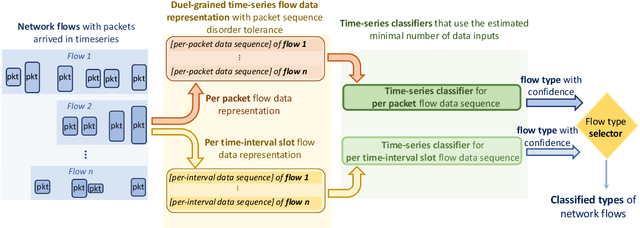
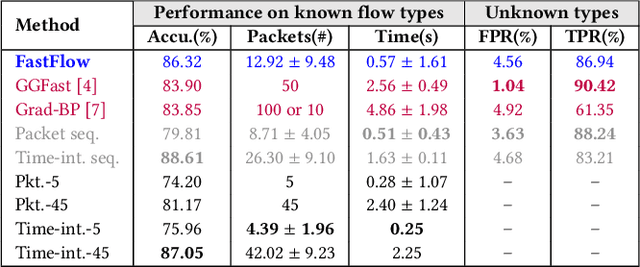
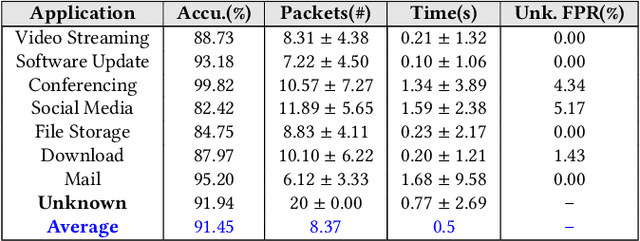
Abstract:Network traffic classification is of great importance for network operators in their daily routines, such as analyzing the usage patterns of multimedia applications and optimizing network configurations. Internet service providers (ISPs) that operate high-speed links expect network flow classifiers to accurately classify flows early, using the minimal number of necessary initial packets per flow. These classifiers must also be robust to packet sequence disorders in candidate flows and capable of detecting unseen flow types that are not within the existing classification scope, which are not well achieved by existing methods. In this paper, we develop FastFlow, a time-series flow classification method that accurately classifies network flows as one of the known types or the unknown type, which dynamically selects the minimal number of packets to balance accuracy and efficiency. Toward the objectives, we first develop a flow representation process that converts packet streams at both per-packet and per-slot granularity for precise packet statistics with robustness to packet sequence disorders. Second, we develop a sequential decision-based classification model that leverages LSTM architecture trained with reinforcement learning. Our model makes dynamic decisions on the minimal number of time-series data points per flow for the confident classification as one of the known flow types or an unknown one. We evaluated our method on public datasets and demonstrated its superior performance in early and accurate flow classification. Deployment insights on the classification of over 22.9 million flows across seven application types and 33 content providers in a campus network over one week are discussed, showing that FastFlow requires an average of only 8.37 packets and 0.5 seconds to classify the application type of a flow with over 91% accuracy and over 96% accuracy for the content providers.
Detecting Anomalous Microflows in IoT Volumetric Attacks via Dynamic Monitoring of MUD Activity
Apr 11, 2023Abstract:IoT networks are increasingly becoming target of sophisticated new cyber-attacks. Anomaly-based detection methods are promising in finding new attacks, but there are certain practical challenges like false-positive alarms, hard to explain, and difficult to scale cost-effectively. The IETF recent standard called Manufacturer Usage Description (MUD) seems promising to limit the attack surface on IoT devices by formally specifying their intended network behavior. In this paper, we use SDN to enforce and monitor the expected behaviors of each IoT device, and train one-class classifier models to detect volumetric attacks. Our specific contributions are fourfold. (1) We develop a multi-level inferencing model to dynamically detect anomalous patterns in network activity of MUD-compliant traffic flows via SDN telemetry, followed by packet inspection of anomalous flows. This provides enhanced fine-grained visibility into distributed and direct attacks, allowing us to precisely isolate volumetric attacks with microflow (5-tuple) resolution. (2) We collect traffic traces (benign and a variety of volumetric attacks) from network behavior of IoT devices in our lab, generate labeled datasets, and make them available to the public. (3) We prototype a full working system (modules are released as open-source), demonstrates its efficacy in detecting volumetric attacks on several consumer IoT devices with high accuracy while maintaining low false positives, and provides insights into cost and performance of our system. (4) We demonstrate how our models scale in environments with a large number of connected IoTs (with datasets collected from a network of IP cameras in our university campus) by considering various training strategies (per device unit versus per device type), and balancing the accuracy of prediction against the cost of models in terms of size and training time.
Modeling Live Video Streaming: Real-Time Classification, QoE Inference, and Field Evaluation
Dec 05, 2021

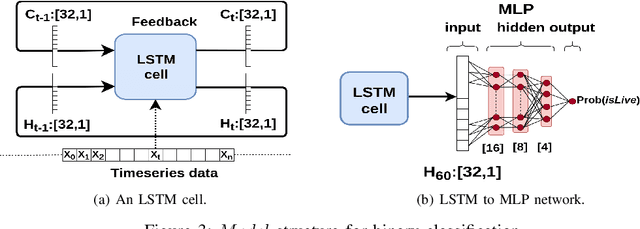
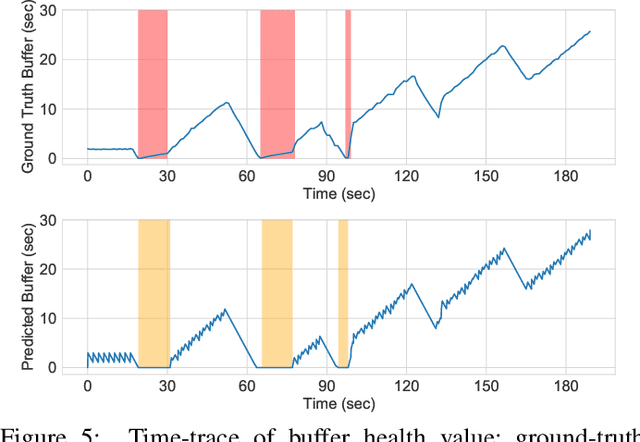
Abstract:Social media, professional sports, and video games are driving rapid growth in live video streaming, on platforms such as Twitch and YouTube Live. Live streaming experience is very susceptible to short-time-scale network congestion since client playback buffers are often no more than a few seconds. Unfortunately, identifying such streams and measuring their QoE for network management is challenging, since content providers largely use the same delivery infrastructure for live and video-on-demand (VoD) streaming, and packet inspection techniques (including SNI/DNS query monitoring) cannot always distinguish between the two. In this paper, we design, build, and deploy ReCLive: a machine learning method for live video detection and QoE measurement based on network-level behavioral characteristics. Our contributions are four-fold: (1) We analyze about 23,000 video streams from Twitch and YouTube, and identify key features in their traffic profile that differentiate live and on-demand streaming. We release our traffic traces as open data to the public; (2) We develop an LSTM-based binary classifier model that distinguishes live from on-demand streams in real-time with over 95% accuracy across providers; (3) We develop a method that estimates QoE metrics of live streaming flows in terms of resolution and buffer stall events with overall accuracies of 93% and 90%, respectively; and (4) Finally, we prototype our solution, train it in the lab, and deploy it in a live ISP network serving more than 7,000 subscribers. Our method provides ISPs with fine-grained visibility into live video streams, enabling them to measure and improve user experience.
Modeling Classroom Occupancy using Data of WiFi Infrastructure in a University Campus
Apr 19, 2021
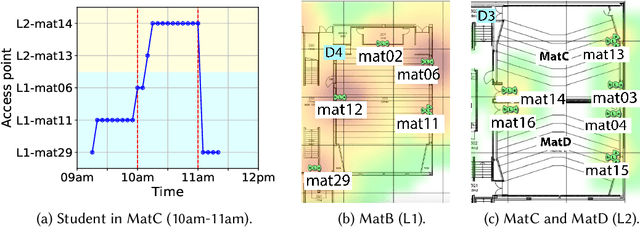


Abstract:Universities worldwide are experiencing a surge in enrollments, therefore campus estate managers are seeking continuous data on attendance patterns to optimize the usage of classroom space. As a result, there is an increasing trend to measure classrooms attendance by employing various sensing technologies, among which pervasive WiFi infrastructure is seen as a low cost method. In a dense campus environment, the number of connected WiFi users does not well estimate room occupancy since connection counts are polluted by adjoining rooms, outdoor walkways, and network load balancing. In this paper, we develop machine learning based models to infer classroom occupancy from WiFi sensing infrastructure. Our contributions are three-fold: (1) We analyze metadata from a dense and dynamic wireless network comprising of thousands of access points (APs) to draw insights into coverage of APs, behavior of WiFi connected users, and challenges of estimating room occupancy; (2) We propose a method to automatically map APs to classrooms using unsupervised clustering algorithms; and (3) We model classroom occupancy using a combination of classification and regression methods of varying algorithms. We achieve 84.6% accuracy in mapping APs to classrooms while the accuracy of our estimation for room occupancy is comparable to beam counter sensors with a symmetric Mean Absolute Percentage Error (sMAPE) of 13.10%.
 Add to Chrome
Add to Chrome Add to Firefox
Add to Firefox Add to Edge
Add to Edge